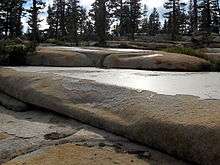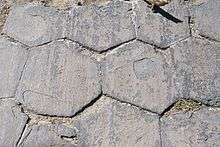Glacial polish
Glacial polish is a characteristic of rock surfaces where glaciers have passed over bedrock, typically granite or other hard igneous or metamorphic rock. Moving ice will carry pebbles and sand grains removed from upper levels which in turn grind a smooth or grooved surface upon the underlying rock.[1] The presence of such polish indicates that the glaciation was relatively recent (in geologic time scale) or was subsequently protected by deposition, as such polish will be subsequently lost due to weathering processes (such as exfoliation).

Low-angle sunlight illuminates glacial polish on granite. Emigrant Wilderness, Sierra Nevada, California, USA. Both flat and pockmarked polish surfaces are visible. The polish itself is a thin layer, some millimeters thick, that is being removed by weathering.

Glacial polish at Devils Postpile National Monument, Madera County, California, USA
References
- Monroe, James S.; Reed Wicander (2004). Changing Earth. Thomson Brooks/Cole. p. 395. ISBN 0-495-01020-0.
This article is issued from Wikipedia. The text is licensed under Creative Commons - Attribution - Sharealike. Additional terms may apply for the media files.